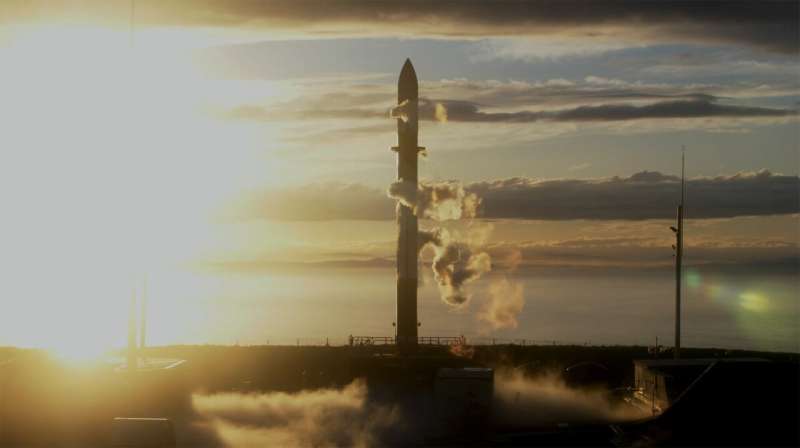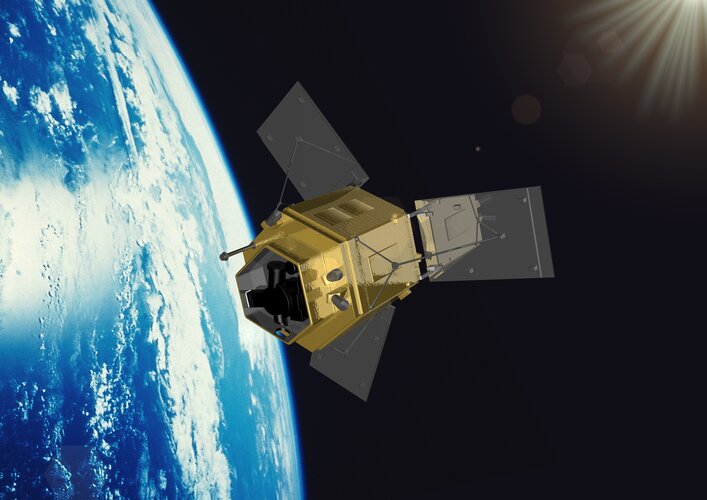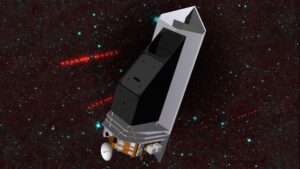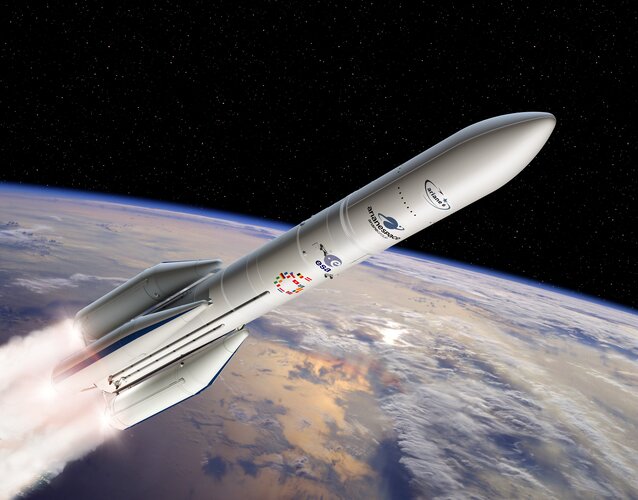Inmarsat report calls for enhanced debris mitigation and stronger regulations in space
Tuesday, 28 June 2022 09:54 Inmarsat, the world leader in global, mobile satellite communications, has issued a far-reaching report on sustainability in space calling on industry operators, national governments and regulators to take coordinated action to reduce space debris, enhance safety and better manage the expansion of mega constellations in Low Earth Orbit (LEO).
The report, produced in partnership with resear
Inmarsat, the world leader in global, mobile satellite communications, has issued a far-reaching report on sustainability in space calling on industry operators, national governments and regulators to take coordinated action to reduce space debris, enhance safety and better manage the expansion of mega constellations in Low Earth Orbit (LEO).
The report, produced in partnership with resear UK Government to review legislation and financial support for debris removal missions
Tuesday, 28 June 2022 09:54 The UK's Department for Business, Energy and Industrial Strategy has announced, during the 4th Summit on Space Sustainability, that it will begin to develop a number of initiatives to help protect our orbital environment. The UK government Plan for Space Sustainability includes a review of secondary legislation and associated regulations focussed on orbital constellations with a view to the upda
The UK's Department for Business, Energy and Industrial Strategy has announced, during the 4th Summit on Space Sustainability, that it will begin to develop a number of initiatives to help protect our orbital environment. The UK government Plan for Space Sustainability includes a review of secondary legislation and associated regulations focussed on orbital constellations with a view to the upda Iran launches 2nd home-made 'Zoljanah' satellite carrier
Tuesday, 28 June 2022 09:54 Spokesman of the Space Department of the Iranian Defense Ministry Ahmad Hosseini said on Sunday that Iran launched a second homemade "Zoljanah" satellite carrier.
Hosseini said that the performance of the three-stage carrier, which uses compound fuel, can be evaluated in each launch.
The second homemade 'Zoljanah' satellite carrier is a sub-orbital satellite carrier that was conducte
Spokesman of the Space Department of the Iranian Defense Ministry Ahmad Hosseini said on Sunday that Iran launched a second homemade "Zoljanah" satellite carrier.
Hosseini said that the performance of the three-stage carrier, which uses compound fuel, can be evaluated in each launch.
The second homemade 'Zoljanah' satellite carrier is a sub-orbital satellite carrier that was conducte Northrop Grumman awarded MDA contract for Hypersonic Missiles defense development
Tuesday, 28 June 2022 09:54Ancient microbes may help us find extraterrestrial life forms
Tuesday, 28 June 2022 09:54 Using light-capturing proteins in living microbes, scientists have reconstructed what life was like for some of Earth's earliest organisms. These efforts could help us recognize signs of life on other planets, whose atmospheres may more closely resemble our pre-oxygen planet.
The earliest living things, including bacteria and single-celled organisms called archaea, inhabited a primarily oc
Using light-capturing proteins in living microbes, scientists have reconstructed what life was like for some of Earth's earliest organisms. These efforts could help us recognize signs of life on other planets, whose atmospheres may more closely resemble our pre-oxygen planet.
The earliest living things, including bacteria and single-celled organisms called archaea, inhabited a primarily oc Observational and modelling data help to decipher the third pole of the world
Tuesday, 28 June 2022 09:54 The Tibetan Plateau, known as the "Third Pole" of the world, is not only the highest plateau on the Earth, but it is also considered the "Asian Water Tower". Its watershed nourishes more than ten major rivers in Asia.
Like the North and South Poles, the Tibetan Plateau is also extremely vulnerable to climate change. Glaciers on it have been retreating extensively in recent decades. Atmosph
The Tibetan Plateau, known as the "Third Pole" of the world, is not only the highest plateau on the Earth, but it is also considered the "Asian Water Tower". Its watershed nourishes more than ten major rivers in Asia.
Like the North and South Poles, the Tibetan Plateau is also extremely vulnerable to climate change. Glaciers on it have been retreating extensively in recent decades. Atmosph Rocketlab launches CAPSTONE on lunar mission for NASA
Tuesday, 28 June 2022 09:54 Rocket Lab USA, Inc. (Nasdaq: RKLB) has launched a satellite to the Moon for NASA from Rocket Lab's Launch Complex 1 on New Zealand's Mahia Peninsula. The launch window opened at 09:50 UTC on June 28th. Designed and built by Tyvak Nano-Satellite Systems, a Terran Orbital Corporation, and owned and operated by Advanced Space on behalf of NASA, the Cislunar Autonomous Positioning System Technology Operations and Navigation Experiment (CAPSTONE) CubeSat will be the first spacecraft to test the Near Rectilinear Halo Orbit (NRHO) around the Moon.
Rocket Lab USA, Inc. (Nasdaq: RKLB) has launched a satellite to the Moon for NASA from Rocket Lab's Launch Complex 1 on New Zealand's Mahia Peninsula. The launch window opened at 09:50 UTC on June 28th. Designed and built by Tyvak Nano-Satellite Systems, a Terran Orbital Corporation, and owned and operated by Advanced Space on behalf of NASA, the Cislunar Autonomous Positioning System Technology Operations and Navigation Experiment (CAPSTONE) CubeSat will be the first spacecraft to test the Near Rectilinear Halo Orbit (NRHO) around the Moon. NASA hopes New Zealand launch will pave way for moon landing
Tuesday, 28 June 2022 09:00
NASA wants to experiment with a new orbit around the moon that it hopes to use in the coming years to once again land astronauts on the lunar surface.
Contract secures design for ESA’s FORUM satellite
Tuesday, 28 June 2022 06:00
ESA has awarded a contract worth €160 million to Airbus in the UK to build the Earth Explorer FORUM satellite. This exciting new mission will yield unique insight into the planet’s radiation budget and how it is controlled – thereby filling in a critical missing piece of the climate jigsaw.
Short for Far-infrared Outgoing Radiation Understanding and Monitoring, FORUM is ESA’s ninth Earth Explorer mission.
Webb's NIRISS instrument is ready to see cosmos in over 2,000 infrared colors
Monday, 27 June 2022 18:23
House appropriators partially restore funding for planetary defense mission
Monday, 27 June 2022 15:31
House appropriators partially restored funding for a planetary defense mission as part of a spending bill while also raising concerns about NASA’s closure of an airborne observatory and plans to return samples from Mars.
The post House appropriators partially restore funding for planetary defense mission appeared first on SpaceNews.
Ariane 6 central core assembly complete
Monday, 27 June 2022 12:14
The central core of a test model of ESA’s new Ariane 6 heavy lift rocket has been assembled for the first time in the purpose-built Launcher Assembly Building at Europe’s Spaceport in French Guiana.
Iran says satellite carrier launched
Monday, 27 June 2022 10:17 Iran's defence ministry said Sunday it has carried out a second test launch of a satellite carrier, ahead of the expected restart of nuclear talks.
"The second launch of the Zoljanah satellite carrier has taken place in order to achieve the predetermined research objectives," said Ahmad Hosseini, spokesman for the ministry's space division, cited by state news agency IRNA.
In February la
Iran's defence ministry said Sunday it has carried out a second test launch of a satellite carrier, ahead of the expected restart of nuclear talks.
"The second launch of the Zoljanah satellite carrier has taken place in order to achieve the predetermined research objectives," said Ahmad Hosseini, spokesman for the ministry's space division, cited by state news agency IRNA.
In February la MDA selects Raytheon to continue developing a first-of-its-kind counter-hypersonic missile
Monday, 27 June 2022 10:17 The Missile Defense Agency has selected Raytheon Missiles and Defense, a Raytheon Technologies business (NYSE: RTX), to continue to develop a first-of-its-kind counter-hypersonic missile, the Glide Phase Interceptor. GPI is designed to intercept hypersonic weapons in the glide phase of flight, providing the U.S. and allies with an additional layer of defense against regional hypersonic missile t
The Missile Defense Agency has selected Raytheon Missiles and Defense, a Raytheon Technologies business (NYSE: RTX), to continue to develop a first-of-its-kind counter-hypersonic missile, the Glide Phase Interceptor. GPI is designed to intercept hypersonic weapons in the glide phase of flight, providing the U.S. and allies with an additional layer of defense against regional hypersonic missile t NASA blasts off from Australian Outback in 'historic' launch
Monday, 27 June 2022 10:17 NASA's first-ever launch from a commercial site outside of the United States blasted off from Australia's Outback late Sunday, in a "historic" moment for the country's space industry.
In the first of three planned launches from the Arnhem Space Centre, the rocket, carrying technology likened to a "mini Hubble" telescope, lifted off - blasted about 350 kilometres (218 miles) into the night s
NASA's first-ever launch from a commercial site outside of the United States blasted off from Australia's Outback late Sunday, in a "historic" moment for the country's space industry.
In the first of three planned launches from the Arnhem Space Centre, the rocket, carrying technology likened to a "mini Hubble" telescope, lifted off - blasted about 350 kilometres (218 miles) into the night s 